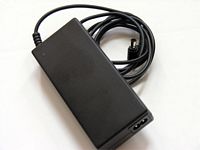Sony VAIO VGN-SZ150P/C - Core Duo
Construction: Field Tested
|
|
|
Charger - Sony has used a variety of power bricks over the years. They have less uniformity in style and size in comparison to a company like Dell. The power brick for this specific notebook is somewhat large, albeit it fairly light for its size (.10 lbs). The only problem we have is that it uses an angled plug, because the power port is not on the side.
Display - This notebook model only comes with one display option: 13.3" WXGA XBRITE TFT LCD (native 1280 x 800).
Simply put, this is a surprisingly bright display. With 9 settings, the display has a wide range between dim and bright. Compared to other notebooks we have used, this is one of the brighter glare type (Sony uses the term "XBRITE") displays. The dimmest setting may be a bit too dark for us to use comfortably in a dark room, but it works fine if you are trying to conserve battery life.
We brought this display outside and it performed in a similar manner with other glare type displays. This display is much better suited for an indoor environment, preferably in a SOHO or entertainment setting.
Considering the size of the notebook, a 13.3" display fits surprisingly well and feels natural. While the notebook's size is close to something of IBM's T series, its layout requires a widescreen notebook, particularly due to the large keyboard.
For multimedia use, this is an excellent display as it mimics the theatric attributes expected of a quality glare type display. Though note that this display also has a fairly wide viewing angle, regardless of its brightness level. This means that the person sitting next to you on a flight will likely be able to see what you see. At the same token, this also means that watching a movie with a friend is not only easy but comfortable.
Fan - The fan was on the majority of the time we had the notebook running. In general, the notebook is quiet, other than the almost inaudible hum of the hard drive and the fan, which comes on intermittently and is slightly louder than the hard drive.
The fan has a low pitch hum and can definitely be heard in normal sitting position within a dead quiet room. However, in a typical office or home environment, you probably will just be able to make out the noise.
Generally, the notebook fan only went to max speed once we were getting into CPU intensive loads. If you are just milling through your "run of the day" computer routine: email, word processing, browsing, etc., the fan will come on intermittently when needed and probably drop down to low speed. When it gets to max speed, the volume is definitely something you can make out in an office environment.
Heat - After about three plus hours of use, the notebook was still relatively cool to the touch. There are three places that got fairly warm after a while though: the bottom where the CPU and memory are located, as well as the left palm rest (hard drive location).








